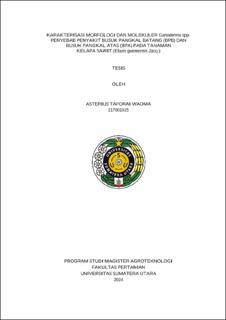Karakterisasi Morfologi dan Molekuler Ganoderma spp. Penyebab Penyakit Busuk Pangkal Batang (BPB) dan Busuk Pangkal Atas (BPA) pada Tanaman Kelapa Sawit (Elaeis guineensis Jacq.)
Morphological and Molecular Characterization of the Ganoderma spp. Causes of Basal Stem Rot (BSR) and Upper Stem Rot (USR) in Oil Palm Plants (Elaeis guineensis Jacq.)

Date
2024Author
Waoma, Asterius Taforai
Advisor(s)
Lisnawita
Hasanuddin
Metadata
Show full item recordAbstract
Sumatera is one of the regions with high productivity in palm oil (Elaeis
guineensis Jacq.) production in Indonesia. However the sustainability of the palm
oil industry in Indonesia could be threatened by the presence of basal stem rot
(BSR) and upper stem rot (USR) which are the main diseases in oil palm cultivation
in Sumatera. BSR and USR diseases are caused by pathogens from the same fungal
genus, namely Ganoderma. There is still little information about variations in
morphological characteristics and genetic diversity of Ganoderma pathogens that
cause BSR and USR diseases in the field. This disease develops slowly and disease
detection is usually done visually by looking at the presence of Ganoderma fruiting
bodies (basidiocarp) on the infected oil palm trees. This study aims to characterize
symptoms, describe morphology (both macroscopis and microscopic) and identify
molecularly the diversity of pathogens that cause BSR and USR to determine the
further disease control strategies. The study was conducted at Asian Agri Group
plantations, which are spread across three provinces (Riau, North Sumatera and
West Sumatera), Ganoderma Laboratory of the Research and Development Center
of Asian Agri Group, Bahilang, Tebing Tinggi and at the Biomolecular Laboratory
of the Royal Golden Eagle Technology Center (RGE-TC) in Pangkalan Kerinci,
Riau from June 2023 to March 2024. The methods used include morphological
description of fruiting bodies, macroscopic and microscopic morphological
description of isolates, soil analysis from trees infected with Ganoderma, molecular
identification using primers ITS1-ITS4 and ITS1F-LR3 as well as phylogenetic tree
reconstruction to investigate the relationship between Ganoderma spp. species
using MEGA 10 software. From this study, a total of 128 Ganoderma samples
consisting of 120 BSR samples and 8 USR samples were characterized by the
morphology of their fruit bodies. Of these, 69 samples were identified as
Ganoderma boninense, which is the dominant species, however, phylogenetically,
this species consists of several different yet closely related strains.
Collections
- Master Theses [429]
